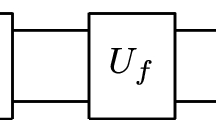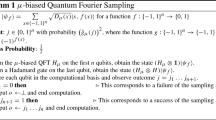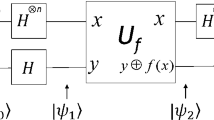Abstract
In this paper, we present a series of new results about learning of concentrated Boolean functions in the quantum computing model. Given a Boolean function f on n variables, its concentration refers to the dominant terms in its Fourier–Walsh spectrum. We show that a quantum probabilistically approximately correct learning model to learn a Boolean function characterized by its concentration yields improvements over the best-known classical method. All of our results are presented within the framework of query complexity, and therefore, our advantage represents asymptotic improvements in the number of queries using a quantum approach over its classical counterpart. Next, we prove a lower bound in the number of quantum queries needed to learn the function in the distribution-independent settings. Further, we examine the case of exact learning which is the learning variant without error. Here, we show that the query complexity grows as \(2^{{\beta }n}\) for some \(0< \beta < 1\) and therefore remains intractable even when quantum approaches are considered. This proof is based on the quantum information theoretic approach developed by researchers for the restricted case of k-sparse functions.
Similar content being viewed by others
Explore related subjects
Discover the latest articles, news and stories from top researchers in related subjects.Data Availability
Data sharing not applicable to this article as no datasets were generated or analyzed during the current study.
References
Aaronson, S.: Read the fine print. Nat. Phys. 11, 291–293 (2015). https://doi.org/10.1038/nphys3272
Adcock, M., Cleve, R.: A quantum Goldreich-Levin theorem with cryptographic applications. In: Alt, H., Ferreira, A. (eds.) STACS 2002, pp. 323–334. Springer, Berlin Heidelberg (2002)
Adcock, M., Cleve, R., Iwama, K., Putra, R., Yamashita, S.: Quantum lower bounds for the Goldreich-Levin problem. Inf. Process. Lett. 97(5), 208–211 (2006)
Aïmeur, E., Brassard, G., Gambs, S.: Machine learning in a quantum world. In: Lamontagne, L., Marchand, M. (eds.) Advances in artificial intelligence, pp. 431–442. Springer, Berlin (2006)
Aïmeur, E., Brassard, G., Gambs, S.: Quantum speed-up for unsupervised learning. Mach. Learn. 90(2), 261–287 (2013). https://doi.org/10.1007/s10994-012-5316-5
Angluin, D.: Queries and concept learning. Mach. Learn. 2(4), 319–342 (1987). https://doi.org/10.1007/BF00116828
Arunachalam, S., Chakraborty, S., Lee, T., Wolf, R.: Two new results about quantum exact learning. In: ICALP (2019)
Arunachalam, S., de Wolf, R.: Guest column: a survey of quantum learning theory. SIGACT News 48(2), 41–67 (2017). https://doi.org/10.1145/3106700.3106710
Arunachalam, S., de Wolf, R.: Optimal quantum sample complexity of learning algorithms. J. Mach. Learn. Res. 19, 71:1–71:36 (2018). http://jmlr.org/papers/v19/18-195.html
Atici, A., Servedio, R.: Improved bounds on quantum learning algorithms. Quant. Inf. Process. 4, 355–386 (2004). https://doi.org/10.1007/s11128-005-0001-2
Atıcı, A., Servedio, R.: Quantum algorithms for learning and testing juntas. Quant. Inf. Process. 6, 323–348 (2007). https://doi.org/10.1007/s11128-007-0061-6
Biamonte, J., Wittek, P., Pancotti, N., Rebentrost, P., Wiebe, N., Lloyd, S.: Quantum machine learning. Nature 549(7671), 195–202 (2017). https://doi.org/10.1038/nature23474
Blumer, A., Ehrenfeucht, A., Haussler, D., Warmuth, M.K.: Learnability and the vapnik-chervonenkis dimension. J. ACM 36(4), 929–965 (1989). https://doi.org/10.1145/76359.76371
Bshouty, N., Jackson, J.: Learning DNF over the uniform distribution using a quantum example oracle. SIAM J. Comput. 28, 1136–1153 (1999). https://doi.org/10.1137/S0097539795293123
Bshouty, N.H., Cleve, R., Gavaldà, R., Kannan, S., Tamon, C.: Oracles and queries that are sufficient for exact learning. J. Comput. Syst. Sci. 52(3), 421–433 (1996). https://doi.org/10.1006/jcss.1996.0032 . https://www.sciencedirect.com/science/article/pii/S002200009690032X
Bshouty, N.H., Jackson, J.C.: Learning dnf over the uniform distribution using a quantum example oracle. SIAM J. Comput. 28(3), 1136–1153 (1998). https://doi.org/10.1137/S0097539795293123
Chia, N.H., Lin, H.H., Wang, C.: Quantum-inspired sublinear classical algorithms for solving low-rank linear systems (2018)
Dunjko, V., Taylor, J.M., Briegel, H.J.: Quantum-enhanced machine learning. Phys. Rev. Lett. 117(13), 130501 (2016). https://doi.org/10.1103/physrevlett.117.130501
Gilyén, A., Lloyd, S., Tang, E.: Quantum-inspired low-rank stochastic regression with logarithmic dependence on the dimension. ArXiv arXiv:1811.04909 (2018)
Goldreich, O., Levin, L.: A hard-core predicate for all one-way functions. pp. 25–32 (1989). https://doi.org/10.1145/73007.73010
Grover, L.K.: A fast quantum mechanical algorithm for database search. In: Proceedings of the Twenty-Eighth Annual ACM Symposium on Theory of Computing, STOC ’96, p. 212-219. Association for Computing Machinery, New York, NY, USA (1996). https://doi.org/10.1145/237814.237866
Harrow, A.W., Hassidim, A., Lloyd, S.: Quantum algorithm for linear systems of equations. Phys. Rev. Lett. 103(15), 150502 (2009)
Hassanieh, H., Indyk, P., Katabi, D., Price, E.: Nearly optimal sparse Fourier transform (2012)
Haviv, I., Regev, O.: The list-decoding size of Fourier-sparse Boolean functions (2015)
Indyk, P., Kapralov, M.: Sparse fourier transform in any constant dimension with nearly-optimal sample complexity in sublinear time (2014)
Kushilevitz, E., Mansour, Y.: Learning decision trees using the Fourier spectrum. SIAM J. Comput. 22(6), 1331–1348 (1993). https://doi.org/10.1137/0222080
Lloyd, S., Mohseni, M., Rebentrost, P.: Quantum principal component analysis. Nat. Phys. 10(9), 631–633 (2014). https://doi.org/10.1038/nphys3029
Nielsen, M.A., Chuang, I.L.: Quantum Computation and Quantum Information: 10th Anniversary Edition, 10th edn. Cambridge University Press, USA (2011)
O’Donnell, R.: Analysis of Boolean Functions. Cambridge University Press, USA (2014)
Rebentrost, P., Mohseni, M., Lloyd, S.: Quantum support vector machine for big data classification. Phys. Rev. Lett. 113(13), 130503 (2014). https://doi.org/10.1103/physrevlett.113.130503
Roh, Y., Heo, G., Whang, S.E.: A survey on data collection for machine learning: a big data – ai integration perspective (2019)
Shalev-Shwartz, S., Ben-David, S.: Understanding machine learning: From theory to algorithms. Cambridge University Press (2014)
Shor, P.W.: Polynomial-time algorithms for prime factorization and discrete logarithms on a quantum computer. SIAM J. Comput. 26(5), 1484–1509 (1997). https://doi.org/10.1137/S0097539795293172
Tang, E.: Quantum-inspired classical algorithms for principal component analysis and supervised clustering (2018)
Tang, E.: A quantum-inspired classical algorithm for recommendation systems. In: Proceedings of the 51st Annual ACM SIGACT Symposium on Theory of Computing, STOC 2019, p. 217-228. Association for Computing Machinery, New York, NY, USA (2019). https://doi.org/10.1145/3313276.3316310
Valiant, L.G.: A theory of the learnable. In: Proceedings of the Sixteenth Annual ACM Symposium on Theory of Computing, STOC ’84, p. 436-445. Association for Computing Machinery, New York, NY, USA (1984). https://doi.org/10.1145/800057.808710
Whalen, J., Wang, Y.: Hottest job in china’s hinterlands: Teaching ai to tell a truck from a turtle. Washingtonpost (2019). https://www.washingtonpost.com/business/2019/09/26/hottest-job-chinas-hinterlands-teaching-ai-tell-truck-turtle/
Wiebe, N., Kapoor, A., Svore, K.: Quantum algorithms for nearest-neighbor methods for supervised and unsupervised learning (2014)
Wiebe, N., Kapoor, A., Svore, K.M.: Quantum deep learning (2015)
Wiebe, N., Kapoor, A., Svore, K.M.: Quantum perceptron models (2016)
Zhang, C.: An improved lower bound on query complexity for quantum pac learning. Inf. Process. Lett. 111(1), 40–45 (2010) https://doi.org/10.1016/j.ipl.2010.10.007. https://www.sciencedirect.com/science/article/pii/S0020019010003133
Funding
This material is based upon work supported by Defense Advanced Research Projects Agency under the Grant No. FA8750-16-2-0004.
Author information
Authors and Affiliations
Corresponding author
Additional information
Publisher's Note
Springer Nature remains neutral with regard to jurisdictional claims in published maps and institutional affiliations.
Rights and permissions
About this article
Cite this article
Palem, K., Pham, D.H. & Rao, M.V.P. Quantum learning of concentrated Boolean functions. Quantum Inf Process 21, 256 (2022). https://doi.org/10.1007/s11128-022-03607-5
Received:
Accepted:
Published:
DOI: https://doi.org/10.1007/s11128-022-03607-5




